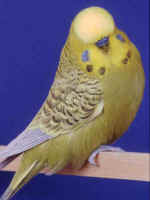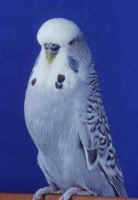
|
Rare
Budgerigar Varieties - The Greywing
by Ghalib Al-Nasser
(Photo left Greywing Grey
Green cock. Best Rare in Show for G & J Al-Nasser at the 1994 Specialist & Rare
Variety Open Show. Photo right Greywing Grey cock, son of the Greywing Grey Green.) |

|
"Beauty is in the eye of the beholder".
This applies to any Budgerigar variety and without a doubt the Greywing variety has got
that certain appeal to many Budgerigar breeders. As a breeder of this variety I found the
challenge to breed a good specimen as rewarding as breeding a good Light Green or a
Skyblue.
The first Greywings were established in around 1919 in Europe and
were of the green series. They were initially called Apple Green or Jade. But when the
Greywing of the blue series was established, initially in Austria in 1927 and then
afterwards in the UK in 1928, the Colour Committee of the Budgerigar Society grouped them
together and gave them the name "Greywings" in 1929.
It is easy to recognise the variety when viewing it in daylight by
the grey marking on the bird in comparison to that of the black on the normal varieties.
By comparing a Greywing Light Green to a normal Light Green the spots, undulations at the
back of the head, markings on the wings and primary wing flights are all of a grey colour
instead of black in the normal varieties. The cheek patches are of light violet and the
body colour is diluted by 50% of the normal body colour. Also the colour of the tail
is grey with a bluish tinge instead of dark blue in the normal varieties.
At times fanciers find it difficult to distinguish between the
Dilutes (Yellows and Whites) and the Greywings, especially if both varieties are of the
grey factor (Greys and Grey Greens). Here a closer look at the body colour and wing
marking of the Grey Yellow and Grey White when compared to Greywing Grey Green and
Greywing Grey is that the body colour of the former is that much further diluted than the
latter. The tail feathers of the Dilutes are off white to pale grey while those of the
Greywing Grey and Grey Green are grey. Without a doubt Greywings are more appealing on
dark factor birds such as Dark Greens and Cobalts.
It was found that a recessive gene controls the Greywing when mated
to normal varieties. So when a Greywing is mated to a normal all the young will be normal
but carrying the Greywing gene in a hidden (split) form; Normal/Greywing. If one of these
splits is mated back to a Greywing then&nbp;50% of the young will be split for
Greywing and the other 50% will be visual Greywings. Mating two Greywings together
will result in all the young being Greywings. Because of the recessive gene it does not
matter much which sex is the visual Greywing as both cocks and hens can be mated and
produced according to the above three types of mating. Also because of that recessive
gene, a bird can be carrying the Greywing factor in a hidden form for many generations.
This is why on occasions a Greywing can pop up in a nest of normal
parents in a stud that does not carry this mutation and the fancier is at a loss as to how
the Greywing appeared. Following the Mendal Theory of Inheritance, pairing two normals
that are split for Greywing will result in 25% of the young being Greywings.
Another 50% will be normal/Greywing and the remainder 25% being pure Normal.
Suddenly the Greywing factor has been established in this stud.
Early breeders established, using Laws of Genetics, that although
the variety is recessive to the normal, it is dominant to the Dilutes (Yellows and
Whites), the same as the Clearwings (Yellow-wings and Whitewings) are dominant to the
Dilutes, even though all the three varieties are recessive. In fact all the three
varieties are separate mutations of the same gene and form what is known as a multiple
allelomorph.
If a Greywing is paired to a Dilute all the chicks will be Greywings
but split for Dilutes. The same will apply if a Clearwing is paired to a Dilute. But
something quite unusual happens when pairing a Greywing to a Clearwing. Here the resulting
young will posses the combination of both varieties in one bird and are called "full
bodied colour Greywings". This means that they have the full body colour of the
Clearwing variety with the Greywing marking; quite an unusual and beautiful coloration.
These full-bodied colour Greywings are split for Clearwing but cannot be split for
Dilutes.
If a full-bodied colour Greywing is paired to a Dilute then the
results will be 50% Greywings and 50% Clearwings all split for Dilutes. However,
if a full bodied colour Greywing is paired to either a Greywing or a Clearwing then the
results will be 50% full bodied colour Greywings and 50% Greywings (or
Clearwings).

Copyright © Ghalib Al-Nasser 2000
all rights reserved.

